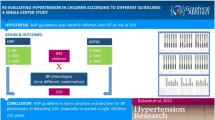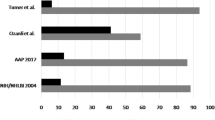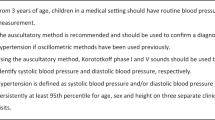Abstract
In children and adolescents, the diagnosis of hypertension is based on office, home and ambulatory blood pressure (BP) measurements. Different normalcy tables for each method have provided 95th percentiles of BP as thresholds for hypertension diagnosis. This study assessed the differences in BP thresholds among these methods when applied in the pediatric population. The most widely used office, home and ambulatory BP normalcy tables were compared in terms of the 50th and 95th percentiles by gender and age. The range of office BP change with increasing age is wider than for home or ambulatory BP in boys and girls, apart from systolic BP in boys. Percentiles of home BP are consistently lower than that of daytime ambulatory BP. There is a trend for office BP to be lower than home or daytime ambulatory BP in the younger age subgroups. This difference is progressively eliminated with increasing age, apart from systolic BP in boys. In conclusion, in children and adolescents, the relationship between office, home and ambulatory BP thresholds provided by the widely used normalcy tables is not the same as in the adults. These findings should be taken into account when evaluating BP measurements in children and adolescents in clinical practice.
This is a preview of subscription content, access via your institution
Access options
Subscribe to this journal
Receive 12 digital issues and online access to articles
$119.00 per year
only $9.92 per issue
Buy this article
- Purchase on Springer Link
- Instant access to full article PDF
Prices may be subject to local taxes which are calculated during checkout

Similar content being viewed by others
References
Lurbe E, Cifkova R, Cruickshank JK, Dillon MJ, Ferreira I, Invitti C et al. Management of high blood pressure in children and adolescents: recommendations of the European Society of Hypertension. J Hypertens 2009; 27: 1719–1742.
National High Blood Pressure Education Program Working Group on High Blood Pressure in Children and Adolescents. The fourth report on the diagnosis, evaluation, and treatment of high blood pressure in children and adolescents. Pediatrics 2004; 114: 555–576.
Lurbe E, Torro I, Alvarez V, Nawrot T, Paya R, Redon J et al. Prevalence, persistence, and clinical significance of masked hypertension in youth. Hypertension 2005; 45: 493–498.
Stergiou GS, Yiannes NJ, Rarra VC, Alamara CV . White-coat hypertension and masked hypertension in children. Blood Press Monit 2005; 10: 297–300.
Stergiou G, Rarra V, Yiannes N . Prevalence and predictors of masked hypertension detected by home blood pressure monitoring in children and adolescents: the Arsakeion school study. Am J Hypertens 2009; 22: 520–524.
Urbina E, Alpert B, Flynn J, Hayman L, Harshfield GA, Jacobson M, et al. American Heart Association Atherosclerosis, Hypertension, and Obesity in Youth Committee. Ambulatory blood pressure monitoring in children and adolescents: recommendations for standard assessment: a scientific statement from the American Heart Association Atherosclerosis, Hypertension, and Obesity in Youth Committee of the council on cardiovascular disease in the young and the council for high blood pressure research. Hypertension 2008; 52: 433–451.
Bald M, Hoyer PF . Measurement of blood pressure at home: a survey among pediatric nephrologists. Pediatr Nephrol 2001; 16: 1058–1062.
Woroniecki RP, Flynn JT . How are hypertensive children evaluated and managed? A survey of North American pediatric nephrologists. Pediatr Nephrol 2005; 20: 791–797.
Stergiou GS, Karpettas N, Kapoyiannis A, Stefanidis CJ, Vazeou A . Home blood pressure monitoring in children and adolescents: a systematic review. J Hypertens 2009; 27: 1941–1947.
de Man SA, André JL, Bachmann H, Grobbee DE, Ibsen KK, Laaser U et al. Blood pressure in childhood: pooled findings of six European studies. J Hypertens 1991; 9: 109–114.
Soergel M, Kirschstein M, Busch C, Danne T, Gellermann J, Holl R et al. Oscillometric twenty-four-hour ambulatory blood pressure values in healthy children and adolescents: a multicenter trial including 1141 subjects. J Pediatr 1997; 130: 178–184.
Wühl E, Witte K, Soergel M, Mehls O, Schaefer F, German Working Group on Pediatric Hypertension. Distribution of 24-h ambulatory blood pressure in children: normalized reference values and role of body dimensions. J Hypertens 2002; 20: 1995–2007.
Stergiou GS, Yiannes NG, Rarra VC, Panagiotakos DB . Home blood pressure normalcy in children and adolescents: the Arsakeion School study. J Hypertens 2007; 25: 1375–1379.
Centers for Disease Control and Prevention. Clinical Growth Charts. http://www.cdc.gov/growthcharts/clinical_charts.htm, Assessed 28 January 2010.
Parati G, Stergiou GS, Asmar R, Bilo G, de Leeuw P, Imai Y et al. ESH Working Group on Blood Pressure Monitoring. European Society of Hypertension guidelines for blood pressure monitoring at home: a summary report of the Second International Consensus Conference on Home Blood Pressure Monitoring. J Hypertens 2008; 26: 1505–1526.
Stergiou GS, Alamara CV, Salgami EV, Vaindirlis IN, Dacou-Voutetakis C, Mountokalakis TD . Reproducibility of home and ambulatory blood pressure in children and adolescents. Blood Press Monit 2005; 10: 143–147.
Belsha CW, Wells TG, Bowe Rice H, Neaville WA, Berry PL . Accuracy of the SpaceLabs 90207 ambulatory blood pressure monitor in children and adolescents. Blood Press Monit 1996; 1: 127–133.
Stergiou GS, Yiannes NG, Rarra VC . Validation of the Omron 705 IT oscillometric device for home blood pressure measurement in children and adolescents: the Arsakion School Study. Blood Press Monit 2006; 11: 229–234.
Wühl E, Hadtstein C, Mehls O, Schaefer F, Escape Trial Group. Home, clinic, and ambulatory blood pressure monitoring in children with chronic renal failure. Pediatr Res 2004; 55: 492–497.
Stergiou GS, Nasothimiou E, Giovas P, Kapoyiannis A, Vazeou A . Diagnosis of hypertension in children and adolescents based on home versus ambulatory blood pressure monitoring. J Hypertens 2008; 26: 1556–1562.
Stergiou GS, Rarra VC, Yiannes NG . Changing relationship between home and office blood pressure with increasing age in children: the Arsakeion school study. Am J Hypertens 2008; 21: 41–46.
Author information
Authors and Affiliations
Corresponding author
Ethics declarations
Competing interests
The authors declare no conflict of interest.
Rights and permissions
About this article
Cite this article
Stergiou, G., Karpettas, N., Panagiotakos, D. et al. Comparison of office, ambulatory and home blood pressure in children and adolescents on the basis of normalcy tables. J Hum Hypertens 25, 218–223 (2011). https://doi.org/10.1038/jhh.2010.59
Received:
Revised:
Accepted:
Published:
Issue Date:
DOI: https://doi.org/10.1038/jhh.2010.59
Keywords
This article is cited by
-
Home Blood Pressure Monitoring in Children and Adolescents: Systematic Review of Evidence on Clinical Utility
Current Hypertension Reports (2019)
-
Management of high blood pressure in children: similarities and differences between US and European guidelines
Pediatric Nephrology (2019)
-
Home blood pressure monitoring in pediatric hypertension: the US perspective and a plan for action
Hypertension Research (2018)
-
Blood pressure (BP) assessment—from BP level to BP variability
Pediatric Nephrology (2016)
-
A systems-based approach to managing blood pressure in children following kidney transplantation
Pediatric Nephrology (2016)



